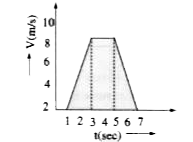A stone falls freely from rest and the total distance covered by it in last second of its motion equals the distance covered by it in the first 3s of its motion. How long the stone will remain in the air?
To solve the problem step by step, we will use the equations of motion under constant acceleration due to gravity.
Step 1: Understand the Problem
We have a stone that falls freely from rest. The distance covered in the last second of its motion is equal to the distance covered in the first 3 seconds of its motion. We need to find the total time the stone remains in the air.
Step 2: Distance Covered in the First 3 Seconds
The distance covered by the stone in the first 3 seconds can be calculated using the second equation of motion:
s=ut+12gt2
Where:
- u = initial velocity = 0 (since it falls from rest)
- g = acceleration due to gravity (approximately 9.8m/s2)
- t = time = 3 seconds
Substituting the values:
s1=0⋅3+12g(32)
s1=12g(9)=9g2
Step 3: Distance Covered in the Last Second
Let the total time of fall be t. The distance covered in the last second (i.e., during the t-th second) can be calculated using the formula:
sn=u+12g(2n−1)
For the last second:
- n=t
- u=0
So,
st=0+12g(2t−1)
st=12g(2t−1)
Step 4: Set the Distances Equal
According to the problem statement, the distance covered in the last second equals the distance covered in the first 3 seconds:
9g2=12g(2t−1)
Step 5: Simplify the Equation
We can cancel 12g from both sides (assuming g≠0):
9=2t−1
Step 6: Solve for t
Now, rearranging the equation:
2t=9+1
2t=10
t=5seconds
Conclusion
The total time the stone remains in the air is 5 seconds.
We have a stone that falls freely from rest. The distance covered in the last second of its motion is equal to the distance covered in the first 3 seconds of its motion. We need to find the total time the stone remains in the air.
The distance covered by the stone in the first 3 seconds can be calculated using the second equation of motion:
s=ut+12gt2
Where:
- u = initial velocity = 0 (since it falls from rest)
- g = acceleration due to gravity (approximately 9.8m/s2)
- t = time = 3 seconds
s1=0⋅3+12g(32)
s1=12g(9)=9g2
Let the total time of fall be t. The distance covered in the last second (i.e., during the t-th second) can be calculated using the formula:
sn=u+12g(2n−1)
For the last second:
- n=t
- u=0
st=0+12g(2t−1)
st=12g(2t−1)
According to the problem statement, the distance covered in the last second equals the distance covered in the first 3 seconds:
9g2=12g(2t−1)
We can cancel 12g from both sides (assuming g≠0):
9=2t−1
Now, rearranging the equation:
2t=9+1
2t=10
t=5seconds
The total time the stone remains in the air is 5 seconds.
Topper's Solved these Questions
- BOOK - VMC MODULES ENGLISHCHAPTER - Motion in Straight Line EXERCISE - SOLVED EXAMPLES20videos
Motion in Straight Line
- BOOK - VMC MODULES ENGLISHCHAPTER - Motion in Straight Line EXERCISE - PRACTICE EXERCISE80videos
Motion in Straight Line
- BOOK - VMC MODULES ENGLISHCHAPTER - MOTION IN A STRAIGHT LINE & PLANE EXERCISE - IMPECCABLE52videos
MOTION IN A STRAIGHT LINE & PLANE
- BOOK - VMC MODULES ENGLISHCHAPTER - Motion in Two DimensionsEXERCISE - MCQ2videos
Motion in Two Dimensions
Similar Questions
A stone falls freely such that the distance covered by it in the last second of its motion is equal to the distance covered by it in the first 5 seconds. It remained in air for :-
View SolutionA stone falls freely rest. The distance covered by it in the last second is equal to the distance covered by it in the first 2 s. The time taken by the stone to reach the ground is
View Solution
Knowledge Check
- Question 1 - Select One
A body falls freely form rest. It covers as much distance in the last second of its motion as covered in the first three seconds. The body has fallen for a time of
A3 sB5 sC7 sD9s
A ball is dropped from the roof of a tower height h. The total distance covered by it in the last second of its motion is equal to the distance covered by it in first three seconds. The value of h in metre is (g=10m/s2)
View SolutionA ball is dropped from the roof of a tower height h. The total distance covered by it in the last second of its motion is equal to the distance covered by it in first three seconds. The value of h in metre is (g=10m/s2)
View SolutionA ball is dropped from the top of a tower of height (h). It covers a distance of h/2 in the last second of its motion. How long does the ball remain in air?
View SolutionA ball falls freely from rest. The ratio of the distance travelled in first, second, third and fourth second is
View SolutionFor the velocity - time graph shown in figure below the distance covered by the body in last two seconds of its motion is what fraction of the total distance covered by it in all the total distance covered by it in all the seven seconds
 View Solution
View SolutionIf the distance travelled by a freely falling body in the last second of its journey is equal to the distance travelled in the first 2s, the time of descent of the body is
View SolutionA ball dropped from the top of a tower covers a distance 7x in the last second of its journey, where x is the distance covered in the first second. How much time does it take to reach to ground?.
View Solution

